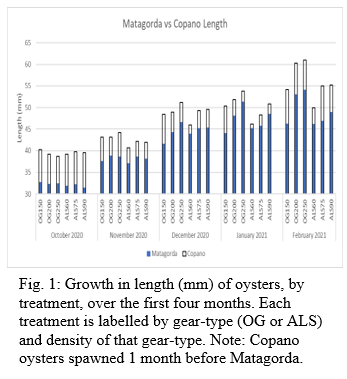COMPARISON OF GROWTH AND MORTALITY OF THE EASTERN OYSTER Crassostrea virginica BY BROODSTOCK SOURCE, GEAR TYPE AND STOCKING DENSITY IN MATAGORDA BAY, TEXAS
Oyster aquaculture in the U.S. has rapidly expanded into a prominent component of the seafood industry. Due to recent passage of enabling legislation, Texas is now poised to become a major contributor. The objective of this research was to characterize growth and mortality of oysters: 1) from different seed/bay sources 2) using different gear-types, and 3) at different stocking densities. Broodstock oysters were obtained from two Texas bays (Copano Bay and Matagorda Bay) and spawned at two hatcheries in Alabama (L3 and Dauphin Island Shellfish Laboratory, respectively). A research farm was established in Palacios, Texas consisting of 29 OysterGro™ (OG) 2-slot floating cage pontoons and 6 Adjustable Longline Systems (ALS) capable of holding 30 growing containers on each line. When seed oysters from both sources were capable of being retained in a 14-mm growing bay, oysters were subdivided into the following treatments and the experiment was initiated. The OG pontoons were stocked at densities of 150, 200 and 250 oysters per bag. There were 4 replicates of 3 densities from 2 broodstock sources for a total of 24 OG growing bags. In the ALS system, oysters were stocked at densities of 60, 75 and 90 oysters per growing container. Th is yielded 10 replicates of 3 densities f rom 2 broodstock sources for a total of 60 ALS replicates.
Monthly samples of 10 oysters from each ALS and OG growing containers were taken with replacement. Length (L), width (W), height (H), and whole wet weight (WWW) of each sample were recorded to yield a growth curve and determine mortality. 20 oysters from each replicate were collected for L, W, H and WWW analysis. From these 20 samples, 10 were collected for determination of condition index (CI) and meat tissue analysis . The results from this study will serve as baseline information for incipient farmers to the Texas industry.
